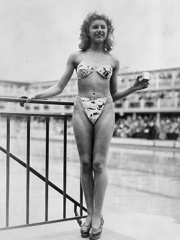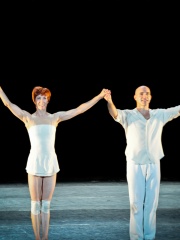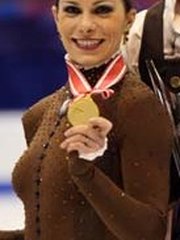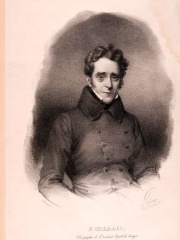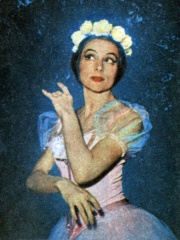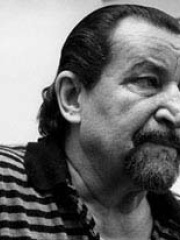
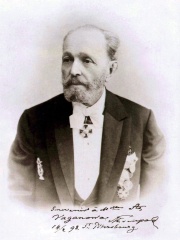
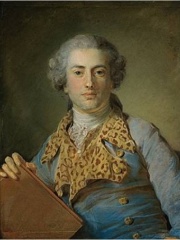
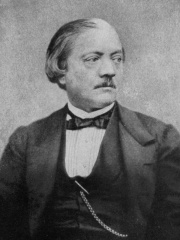
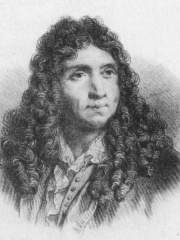
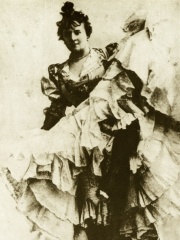
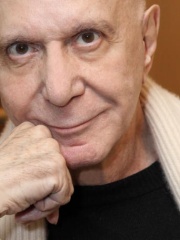
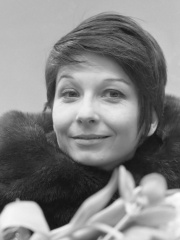
The Most Famous
DANCERS from France
This page contains a list of the greatest French Dancers. The pantheon dataset contains 116 Dancers, 15 of which were born in France. This makes France the birth place of the 3rd most number of Dancers behind Russia, and United States.
Top 10
The following people are considered by Pantheon to be the top 10 most legendary French Dancers of all time. This list of famous French Dancers is sorted by HPI (Historical Popularity Index), a metric that aggregates information on a biography's online popularity. Visit the rankings page to view the entire list of French Dancers.

1. Maurice Béjart (1927 - 2007)
With an HPI of 73.16, Maurice Béjart is the most famous French Dancer. His biography has been translated into 53 different languages on wikipedia.
Maurice Béjart (French: [beʒaʁ]; 1 January 1927 – 22 November 2007) was a French dancer, choreographer and opera director who ran the Béjart Ballet Lausanne in Switzerland. He developed a popular expressionistic form of modern ballet, tackling vast themes. He was awarded Swiss citizenship posthumously.

2. Marius Petipa (1818 - 1910)
With an HPI of 73.03, Marius Petipa is the 2nd most famous French Dancer. His biography has been translated into 46 different languages.
Marius Ivanovich Petipa (Russian: Мариус Иванович Петипа; born Victor Marius Alphonse Petipa; 11 March 1818 – 14 July [O.S. 1 July] 1910) was a French and Russian ballet dancer, pedagogue and choreographer. He is considered one of the most influential ballet masters and choreographers in ballet history. Petipa is noted for his long career as Premier maître de ballet (First Ballet Master) of the St. Petersburg Imperial Theatres, making him Ballet Master and principal choreographer of the Imperial Ballet (today known as the Mariinsky Ballet), a position he held from 1871 until 1903. Petipa created over fifty ballets, some of which have survived in versions either faithful to, inspired by, or reconstructed from his originals. He is most noted for The Pharaoh's Daughter (1862); Don Quixote (1869); La Bayadère (1877); Le Talisman (1889); The Sleeping Beauty (1890); The Nutcracker (choreographed jointly with Lev Ivanov) (1892); Le Réveil de Flore (1894); La Halte de cavalerie (1896); Raymonda (1898); Les Saisons (1900), and Les Millions d'Arlequin (a.k.a. Harlequinade) (1900). Petipa also revived a substantial number of works created by other choreographers. Many of his revivals have become the basis of the majority of subsequent productions of those works. The most famous of Petipa's revivals are Le Corsaire, Giselle, La Esmeralda, Coppélia, La Fille Mal Gardée (with Lev Ivanov), The Little Humpbacked Horse and Swan Lake (with Lev Ivanov). Many individual numbers taken from Petipa's work (both from original works and from revivals) continued to be performed independently, in spite of the fact that the full-length ballets that spawned them had disappeared from the Imperial Ballet's repertoire. Many of these pieces have endured in versions either based on the original or choreographed anew by others – the Grand Pas classique, Pas de trois and Mazurka des enfants from Paquita; Le Carnaval de Venise Pas de deux; The Talisman Pas de deux; La Esmeralda Pas de deux; the Diana and Actéon Pas de deux; La Halte de Cavalerie Pas de deux; the Don Quixote Pas de deux; La Fille Mal Gardée Pas de deux; and the Harlequinade Pas de deux.

3. Jean-Georges Noverre (1727 - 1810)
With an HPI of 69.59, Jean-Georges Noverre is the 3rd most famous French Dancer. His biography has been translated into 28 different languages.
Jean-Georges Noverre (French pronunciation: [ʒɑ̃ ʒɔʁʒ nɔvɛʁ]; 29 April 1727 – 19 October 1810) was a French dancer and ballet master, and is generally considered the creator of ballet d'action, a precursor of the narrative ballets of the 19th century. His birthday is now observed as International Dance Day. His first professional appearances occurred as a youth in Paris at the Opéra-Comique, at Fontainebleau, in Berlin before Frederick II and his brother Prince Henry of Prussia, in Dresden and Strasburg. In 1747 he moved to Strasbourg, where he remained until 1750 before moving to Lyon. In 1751, he composed his first great work, Les Fêtes Chinoises for Marseilles. The work was revived in Paris in 1754 to great acclaim. In 1755, he was invited by Garrick to London, where he remained for two years. Between 1758 and 1760 he produced several ballets at Lyon, and published his Lettres sur la danse et les ballets. It is from this period that the revolution in the art of the ballet for which Noverre was responsible can be dated. Prior to Noverre, ballets were large spectacles that focused mainly on elaborate costumes and scenery and not on the physical and emotional expression of the dancers. He was next engaged by Duke Karl Eugen of Württemberg, and later Austrian Empress Maria Theresa, until 1774. In 1776, he was appointed maître des ballets of the Paris Opera at the request of Queen Marie Antoinette. He returned to Vienna in Spring of 1776 to stage ballets there, but in June 1776 he returned again to Paris. He regained this post until the French Revolution reduced him to poverty. He died on 19 October 1810 at Saint-Germain-en-Laye. Noverre's friends included Voltaire, Mozart, Frederick the Great and David Garrick (who called him "the Shakespeare of the dance"). The ballets of which he was most proud were his La Toilette de Vénus, Les Jalousies du sérail, L'Amour corsaire and Le Jaloux sans rival. Besides the Lettres sur la danse, Noverre wrote Observations sur la construction d'une nouvelle salle de l'Opéra (1781); Lettres sur Garrick écrites à Voltaire (1801); and Lettre à un artiste sur les fêtes publiques (1801).

4. Jules Perrot (1810 - 1892)
With an HPI of 64.29, Jules Perrot is the 4th most famous French Dancer. His biography has been translated into 21 different languages.
Jules-Joseph Perrot (18 August 1810 – 29 August 1892) was a French dancer and choreographer who later became Ballet Master of the Imperial Ballet in St. Petersburg, Russia. He created some of the most famous ballets of the 19th century including Pas de Quatre, La Esmeralda, Ondine, and Giselle with Jean Coralli.
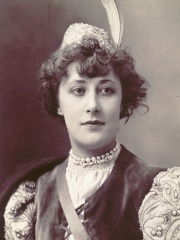
5. Liane de Pougy (1869 - 1950)
With an HPI of 64.29, Liane de Pougy is the 5th most famous French Dancer. Her biography has been translated into 23 different languages.
Liane de Pougy (born Anne-Marie Chassaigne, 2 July 1869 – 26 December 1950) was a French dancer, courtesan and novelist. She was a Folies Bergère vedette, and was known as one of the most beautiful and notorious courtesans in Paris. Later in life, she became a Dominican tertiary.

6. Pierre Beauchamp (1631 - 1705)
With an HPI of 64.26, Pierre Beauchamp is the 6th most famous French Dancer. His biography has been translated into 19 different languages.
Pierre Beauchamp or Beauchamps (French pronunciation: [pjɛʁ boʃɑ̃]; 30 October 1631 – February 1705) was a French choreographer, dancer and composer, and the probable inventor of Beauchamp–Feuillet notation. His grand-father was called Christophe (a musician) and his father, a violinist of the king's chamber, was simply called Louis. Following a custom of the time, Pierre Beauchamp was named Pierre after his godfather Pierre Vacherot, tailor of the queen's pages and a relative of the Beauchamps family.

7. La Goulue (1866 - 1929)
With an HPI of 63.84, La Goulue is the 7th most famous French Dancer. Her biography has been translated into 20 different languages.
La Goulue (French pronunciation: [la guly], meaning The Glutton), was the stage name of Louise Weber (12 July 1866 – 29 January 1929), a French can-can dancer who was a star of the Moulin Rouge, a popular cabaret in the Pigalle district of Paris, near Montmartre. Weber became known as La Goulue because as an adolescent, she was known for guzzling cabaret patrons' drinks while dancing. She also was referred to as the Queen of Montmartre.

8. Roland Petit (1924 - 2011)
With an HPI of 63.30, Roland Petit is the 8th most famous French Dancer. His biography has been translated into 22 different languages.
Roland Petit (13 January 1924 – 10 July 2011) was a French ballet company director, choreographer and dancer. He trained at the Paris Opera Ballet school, and became well known for his creative ballets.

9. Zizi Jeanmaire (1924 - 2020)
With an HPI of 61.49, Zizi Jeanmaire is the 9th most famous French Dancer. Her biography has been translated into 25 different languages.
Renée Marcelle "Zizi" Jeanmaire (29 April 1924 – 17 July 2020) was a French ballet dancer, actress and singer. She became famous in the 1950s after playing the title role in the ballet Carmen, produced in London in 1949, and went on to appear in several Hollywood films and Paris revues. She was the wife of dancer and choreographer Roland Petit, who created ballets and revues for her.
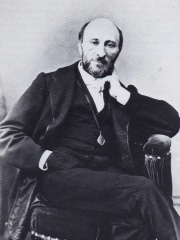
10. Arthur Saint-Léon (1821 - 1870)
With an HPI of 60.39, Arthur Saint-Léon is the 10th most famous French Dancer. His biography has been translated into 17 different languages.
Arthur Saint-Léon (17 September 1821, in Paris – 2 September 1870) was the Maître de Ballet of St. Petersburg Imperial Ballet from 1859 until 1869 and is famous for creating the choreography of the ballet Coppélia.
People
Pantheon has 15 people classified as French dancers born between 1631 and 1978. Of these 15, 3 (20.00%) of them are still alive today. The most famous living French dancers include Micheline Bernardini, Sylvie Guillem, and Isabelle Delobel. The most famous deceased French dancers include Maurice Béjart, Marius Petipa, and Jean-Georges Noverre. As of April 2024, 1 new French dancers have been added to Pantheon including Isabelle Delobel.
Living French Dancers
Go to all RankingsMicheline Bernardini
1927 - Present
HPI: 58.30
Sylvie Guillem
1965 - Present
HPI: 56.83
Isabelle Delobel
1978 - Present
HPI: 40.66
Deceased French Dancers
Go to all RankingsMaurice Béjart
1927 - 2007
HPI: 73.16
Marius Petipa
1818 - 1910
HPI: 73.03
Jean-Georges Noverre
1727 - 1810
HPI: 69.59
Jules Perrot
1810 - 1892
HPI: 64.29
Liane de Pougy
1869 - 1950
HPI: 64.29
Pierre Beauchamp
1631 - 1705
HPI: 64.26
La Goulue
1866 - 1929
HPI: 63.84
Roland Petit
1924 - 2011
HPI: 63.30
Zizi Jeanmaire
1924 - 2020
HPI: 61.49
Arthur Saint-Léon
1821 - 1870
HPI: 60.39
Jean Coralli
1779 - 1854
HPI: 59.38
Yvette Chauviré
1917 - 2016
HPI: 57.73
Newly Added French Dancers (2025)
Go to all RankingsOverlapping Lives
Which Dancers were alive at the same time? This visualization shows the lifespans of the 10 most globally memorable Dancers since 1700.

